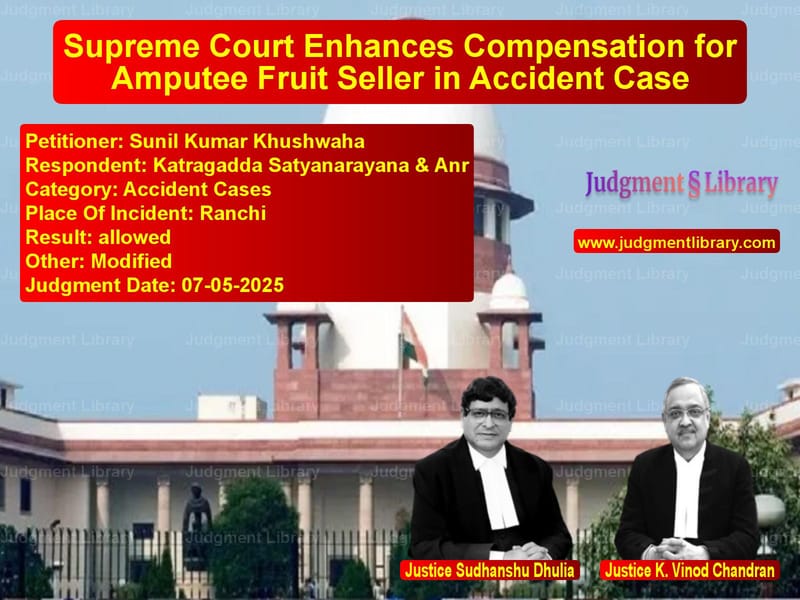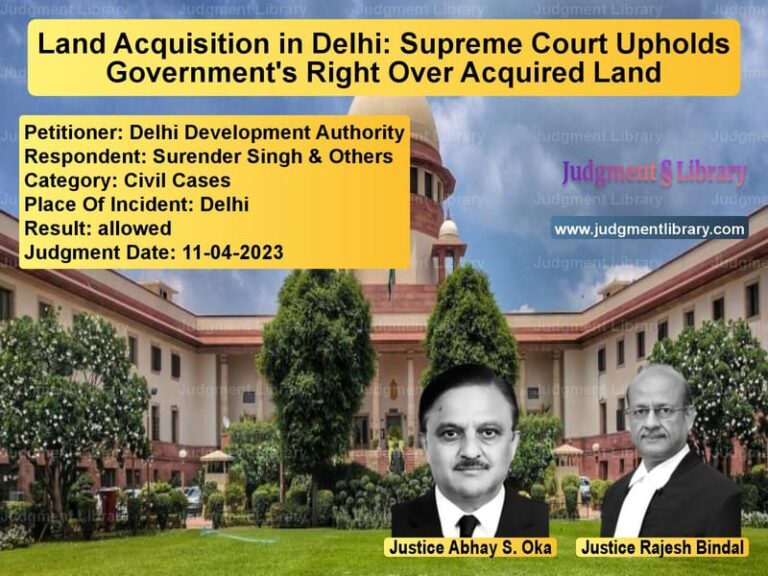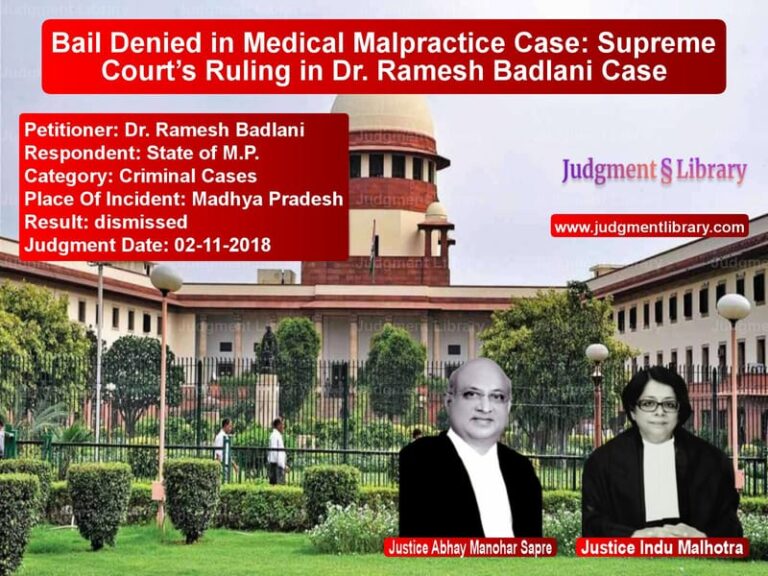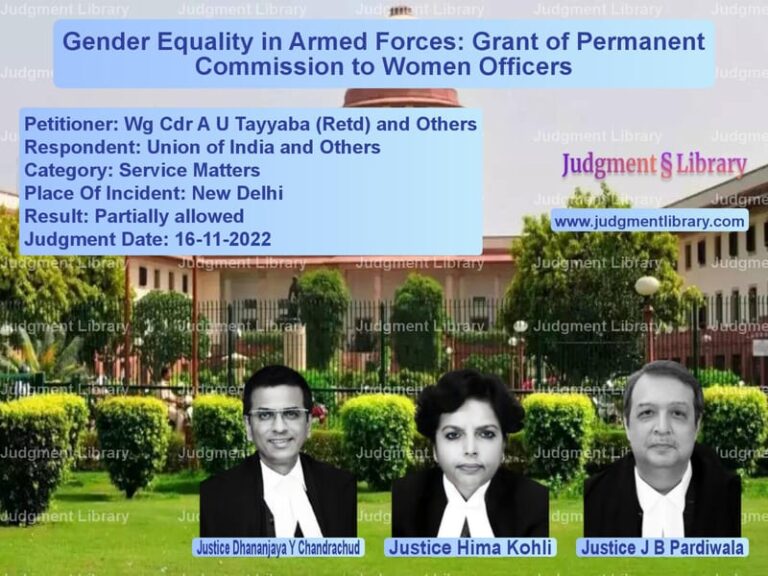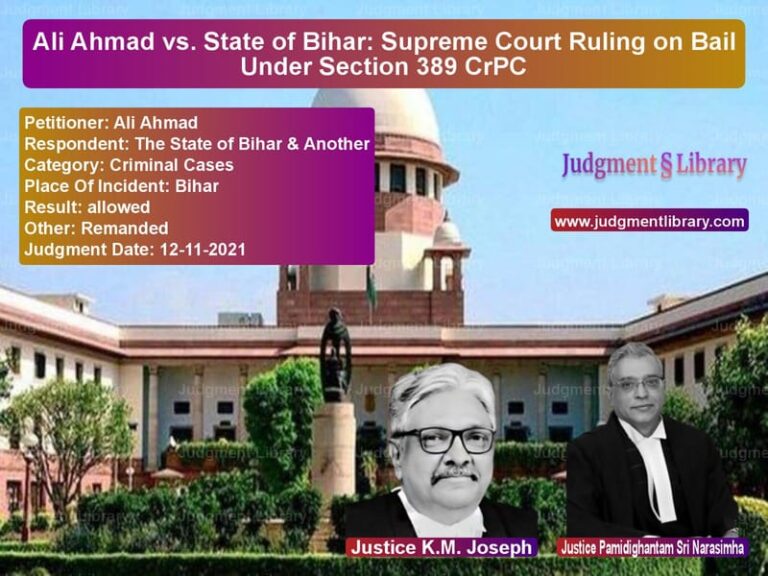Supreme Court Enhances Compensation for Amputee Fruit Seller in Accident Case
In a significant judgment that clarifies the principles for assessing compensation in cases of permanent disability due to motor accidents, the Supreme Court of India recently enhanced the compensation awarded to a fruit seller who lost his leg in a road accident. The case of Sunil Kumar Khushwaha versus Katragadda Satyanarayana & Anr., decided on May 7, 2025, by a bench comprising Justice Sudhanshu Dhulia and Justice K. Vinod Chandran, addresses crucial questions about how courts should evaluate functional disability and calculate compensation for victims who suffer life-altering injuries. This judgment provides important guidance on distinguishing between physical disability and functional disability, particularly for self-employed individuals whose livelihoods depend on physical mobility.
The Tragic Accident and Its Consequences
The case originated from a devastating accident where two pedestrians were struck by a rashly and negligently driven truck. The appellant, Sunil Kumar Khushwaha, suffered grievous injuries that ultimately led to the amputation of his right leg from the knee. The sequence of medical treatment highlighted the severity of his condition – he was first taken to a local hospital, then shifted to a specialized hospital, and finally transported to Delhi from Ranchi for advanced treatment where the amputation was performed.
The appellant was a fruit seller by profession, and the accident had catastrophic implications for his livelihood. Documentary evidence presented before the court included Income Tax Returns (Exhibit-5) that showed his annual income to be Rs. 1,56,996. This established his earning capacity prior to the accident and formed the basis for calculating compensation for loss of future income.
The Legal Journey Through Lower Courts
The Motor Accident Claims Tribunal initially awarded compensation of Rs. 7,09,273 to the appellant. The bulk of this amount (Rs. 5,00,949) was allocated towards medical bills, reflecting the substantial healthcare expenses incurred due to the severe injuries and subsequent amputation. Other components included Rs. 19,624 for income loss during treatment for one and a half months, Rs. 13,700 for conveyance expenses, and Rs. 1,75,000 for pain and suffering.
However, the Tribunal made a significant omission by not granting any compensation for loss of income due to the permanent disability suffered by the appellant. This became a central issue in the subsequent appeals.
The High Court, while hearing the appeal, relied on the precedent set in Raj Kumar v. Ajay Kumar and Anr., which emphasized the need to assess functional disability rather than merely relying on physical disability certificates when granting compensation. In the present case, a doctor had been examined who produced Exhibit-4/1, a disability certificate issued by a Medical Board after examining the injured appellant. This certificate assessed the appellant as having 50% permanent disability due to the amputation of his right leg.
Arguments Before the Supreme Court
Before the Supreme Court, Mr. Karan Deep Singh, the learned counsel for the appellant, made a compelling argument regarding the impact of the disability on his client’s livelihood. He contended that “since the appellant was a fruit seller, he could no longer carry out such sales and hence there is a 100% functional disability in so far as the chosen vocation.” This argument emphasized that while the physical disability was 50%, the functional disability – the impact on his ability to earn a livelihood – was complete, as his profession required mobility and physical presence that he could no longer provide.
On the other side, Mr. Ambhoj Kumar Sinha, the learned counsel for the respondent-Insurance Company, sought to uphold the order of the High Court, likely arguing that the compensation already awarded was adequate and that the assessment of disability should be limited to the physical disability certified by the Medical Board.
The Supreme Court’s Analysis and Reasoning
The Supreme Court conducted a nuanced analysis of the concept of functional disability and its application in compensation cases. The Court acknowledged the appellant’s arguments but offered a more balanced approach to assessing functional disability.
The Court stated: “We are not satisfied that a functional disability of 100% can be assessed only because he cannot carry on the vocation which he was carrying on earlier.” This observation reflected the Court’s view that while the disability significantly impacted the appellant’s current profession, it did not necessarily render him completely incapable of any economic activity.
The Court provided important reasoning for this position: “It is not as if the appellant was vending fruit on his foot, especially when it is seen that he was filing an Income Tax Return. It is also evident from the deposition of CW-2 that the injured was having a shop in Bazar Samiti.” This suggested that the appellant might have been operating from a fixed shop rather than as a mobile street vendor, which could affect the extent to which the disability impacted his business.
However, the Court fully recognized that the disability would substantially affect the appellant’s income and business operations. The judges observed: “Definitely, the disability would affect his income, and he would probably have to engage an employee in his shop.” This acknowledgment formed the basis for awarding substantial compensation for loss of future earning capacity.
The Court drew guidance from the precedent in Raj Kumar v. Ajay Kumar, noting: “In Raj Kumar (supra), a self-employed person engaged in a business, who had to amputate his left leg, pursuant to a motor vehicle accident, was assessed with a functional disability of 60% by the Tribunal, which was found to be proper.” Following this precedent, the Court concluded: “Hence, in the present case, functional disability can be assessed at 60%.”
The Supreme Court’s Compensation Calculation
The Supreme Court undertook a comprehensive recalculation of compensation, considering all relevant factors. The Court enhanced several components of the compensation beyond what had been awarded by the lower courts.
For conveyance charges, considering the extensive travel required for medical treatment – from local hospital to specialized hospital and then to Delhi – the Court fixed this amount at Rs. 50,000, significantly higher than the Rs. 13,700 awarded by the Tribunal.
For pain and suffering, taking into account the traumatic experience of leg amputation, the Court enhanced this component to Rs. 2,00,000 from the Tribunal’s award of Rs. 1,75,000.
The Court accepted the High Court’s finding of a reasonable bed rest period of 6 months and awarded Rs. 15,000 per month for special diet and attendant charges during this period.
The most significant enhancement came in the calculation for loss of future income. Using the multiplier method, the Court computed: “Loss of income. Rs.1,56,996 x 140% x 18 x 60%” which amounted to Rs. 23,73,780. This calculation incorporated the appellant’s established annual income (Rs. 1,56,996), future prospects (140% of current income), an appropriate multiplier of 18 (considering the appellant’s age), and the assessed functional disability of 60%.
The comprehensive compensation breakdown as finalized by the Supreme Court was as follows:
Loss of future income: Rs. 23,73,780
Medical expenses: Rs. 5,00,949
Conveyance charges: Rs. 50,000
Pain and suffering: Rs. 2,00,000
Income loss for 1½ months: Rs. 19,624
Special diet and attendant charges for six months: Rs. 90,000
Total compensation: Rs. 32,34,353
This amounted to more than four times the original compensation awarded by the Tribunal, reflecting the Court’s recognition of the long-term impact of the disability on the appellant’s life and livelihood.
Legal Principles Established
This judgment reinforces several important legal principles in motor accident compensation cases:
First, it emphasizes the distinction between physical disability and functional disability. While medical boards assess physical disability based on anatomical and physiological impairment, courts must evaluate functional disability based on how the impairment affects the victim’s ability to earn a livelihood.
Second, the judgment establishes that complete functional disability (100%) should not be presumed merely because a victim can no longer continue their pre-accident profession. Courts must consider whether alternative means of livelihood remain possible, though likely at reduced earning capacity.
Third, the judgment follows the precedent in Raj Kumar v. Ajay Kumar in applying a 60% functional disability for leg amputation cases involving self-employed individuals, providing consistency in compensation assessments across similar cases.
Fourth, the Court demonstrated a comprehensive approach to compensation, ensuring that all aspects of the victim’s loss – including medical expenses, conveyance, pain and suffering, and long-term loss of earning capacity – are adequately compensated.
Implementation and Directions
The Supreme Court directed that the enhanced compensation amount of Rs. 32,34,353 be paid to the appellant after deducting whatever amount had already been paid. The Court mandated that this payment be made with interest as directed by the Tribunal, running from the date of filing of the claim petition, within a period of two months.
To facilitate efficient disbursement, the Court directed the appellant to provide his account details to enable online deposit of the compensation amount by the insurance company within the stipulated period.
Broader Implications
This judgment has significant implications for future motor accident compensation cases, particularly those involving permanent disabilities. It provides clearer guidelines for assessing functional disability, especially for self-employed individuals whose livelihoods may be disproportionately affected by specific disabilities.
The judgment balances the interests of accident victims and insurance companies by adopting a reasonable approach to functional disability assessment – neither automatically assuming 100% functional disability nor limiting compensation to physical disability percentages.
For accident victims, this judgment reinforces that courts will take a comprehensive view of how disabilities impact earning capacity and quality of life, ensuring that compensation reflects the true extent of their losses.
For the legal community, the judgment provides valuable precedent on calculating compensation using established methodologies while applying appropriate functional disability percentages based on the nature of the disability and the victim’s profession.
The Supreme Court’s approach in this case demonstrates the judiciary’s commitment to ensuring that accident victims receive fair and adequate compensation that enables them to maintain a reasonable quality of life despite their disabilities, while maintaining a balanced and principled approach to compensation calculation.
Petitioner Name: Sunil Kumar Khushwaha.Respondent Name: Katragadda Satyanarayana & Anr.Judgment By: Justice Sudhanshu Dhulia, Justice K. Vinod Chandran.Place Of Incident: Ranchi.Judgment Date: 07-05-2025.Result: allowed.
Don’t miss out on the full details! Download the complete judgment in PDF format below and gain valuable insights instantly!
Download Judgment: sunil-kumar-khushwah-vs-katragadda-satyanara-supreme-court-of-india-judgment-dated-07-05-2025.pdf
Directly Download Judgment: Directly download this Judgment
See all petitions in Road Accident Cases
See all petitions in Compensation Disputes
See all petitions in Motor Vehicle Act
See all petitions in Negligence Claims
See all petitions in Insurance Settlements
See all petitions in Judgment by Sudhanshu Dhulia
See all petitions in Judgment by K. Vinod Chandran
See all petitions in allowed
See all petitions in Modified
See all petitions in supreme court of India judgments May 2025
See all petitions in 2025 judgments
See all posts in Accident Cases Category
See all allowed petitions in Accident Cases Category
See all Dismissed petitions in Accident Cases Category
See all partially allowed petitions in Accident Cases Category

